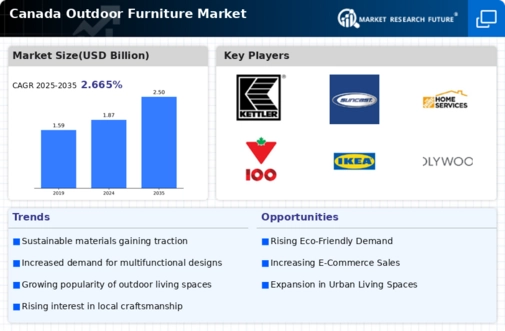The outdoor furniture market in Canada is characterized by a dynamic competitive landscape, driven by evolving consumer preferences and a growing emphasis on sustainability. Key players such as IKEA (SE), Herman Miller (US), and Trex Company (US) are strategically positioned to leverage innovation and sustainability in their offerings. IKEA (SE) focuses on affordable, stylish designs that appeal to a broad demographic, while Herman Miller (US) emphasizes ergonomic and high-end designs, catering to a niche market. Trex Company (US) stands out with its commitment to eco-friendly materials, particularly in composite decking and furniture, which aligns with the increasing consumer demand for sustainable products. Collectively, these strategies shape a competitive environment that prioritizes design, sustainability, and consumer engagement.
In terms of business tactics, companies are increasingly localizing manufacturing and optimizing supply chains to enhance efficiency and reduce costs. The market structure appears moderately fragmented, with several players vying for market share. However, the influence of major companies is significant, as they set trends and standards that smaller firms often follow. This competitive structure fosters innovation and encourages companies to differentiate themselves through unique product offerings and customer experiences.
In October 2025, IKEA (SE) announced the launch of a new line of outdoor furniture made from 100% recycled materials. This strategic move not only reinforces IKEA's commitment to sustainability but also positions the company as a leader in eco-friendly outdoor solutions. By tapping into the growing consumer preference for sustainable products, IKEA (SE) is likely to enhance its market share and brand loyalty among environmentally conscious consumers.
In September 2025, Trex Company (US) unveiled a partnership with a leading technology firm to develop smart outdoor furniture that integrates IoT capabilities. This initiative reflects a growing trend towards digitalization in the outdoor furniture sector, allowing consumers to monitor and control their outdoor environments through mobile applications. Such innovation could potentially redefine consumer interactions with outdoor spaces, enhancing convenience and functionality.
In August 2025, Herman Miller (US) expanded its product line to include modular outdoor furniture designed for urban living. This strategic expansion caters to the increasing demand for versatile and space-saving solutions in urban environments. By addressing the specific needs of city dwellers, Herman Miller (US) is likely to capture a new segment of the market, further solidifying its position as a premium brand in the outdoor furniture space.
As of November 2025, current competitive trends indicate a strong focus on digitalization, sustainability, and the integration of advanced technologies such as AI in product development. Strategic alliances are increasingly shaping the landscape, enabling companies to pool resources and expertise to innovate more effectively. Looking ahead, competitive differentiation is expected to evolve, with a shift from price-based competition to a focus on innovation, technology, and supply chain reliability. Companies that can effectively integrate these elements into their strategies are likely to thrive in the increasingly competitive outdoor furniture market.

















Leave a Comment